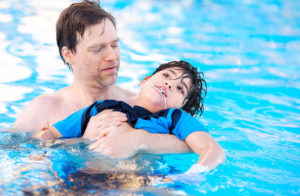Aquatic Therapy for Children with CP
One form of physical therapy gaining in popularity for those with cerebral palsy is aquatic therapy. This is designed so that those with mobility problems can exercise in water, which can provide for more-intense workouts while not requiring the individual to worry about balance.
Aquatic therapy for cerebral palsy relieves pressure on the joints and makes the child feel weightless. This allows sufferers to gain a wider range of motion. Resistance in the water also triggers muscle growth because the patients must often exercise different muscle groups.
Diane Damiano, president of the American Academy of Cerebral Palsy and Developmental Research, says that this type of physical therapy has many implications for therapeutic care. She also states that such forms of therapy may help the increasingly-sedentary general population of aging adults with CP.
Opening New Avenues to Sports

Aquatic Therapy for Kids with CP
Phillip Wickman doesn’t look like a traditional basketball player when he is seated in his wheelchair. However, in the water, this 14-year-old with cerebral palsy is a basketball superstar. Although Phillip has a hard time controlling his limbs on land, in the water, he says he has much more control over his own body.
Phillip’s father says that walking and standing were agony for Phillip during his regular physical therapy. “When Phillip tried to walk with a walker, his legs would cross, causing him to trip and become frustrated.” Since he began aquatic therapy, Phillip has improved greatly and is showing more and more strength and mobility.
Every year, aquatic therapy is being used more and more-often for children with cerebral palsy. This treatment has been around a while, but it is only recently received widespread support and acceptance from therapists.
